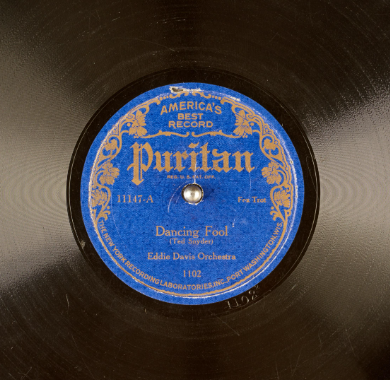Table of Contents
Rediscovering Puritan Records: A Dive into an Overlooked Era of Music
Amidst the crackle and hiss of an old shellac record spins a delightfully whimsical tune – “Dancing Fool” by the Eddie Davis Orchestra, a hidden gem from the Puritan label’s catalog. This forgotten relic, unearthed on April Fool’s Day, serves as the catalyst for delving into the fascinating world of Puritan Records, an often-overlooked imprint that offers a unique glimpse into the musical tastes and sounds of the early 20th century.

Puritan Records was born in 1917, established by the Wisconsin Chair Company in Port Washington, Wisconsin. What might seem like an odd pairing – a furniture company and a record label – was actually a clever business strategy during a time when phonographs were becoming popular household items. Initially, Puritan even predated the Wisconsin Chair Company’s more famous label, Paramount Records.
Puritan’s lifespan, though relatively short, mirrored the heyday of 78rpm records. It ultimately ceased operations in 1929, ending an era that produced a diverse catalog of musical treasures.
One of the challenges in identifying “famous” artists on Puritan is that the stars of the early 20th century weren’t necessarily the household names they’d become later. Additionally, many musicians would release records under multiple labels and sometimes even pseudonyms.
However, Puritan did boast some notable talent, including:
- Arthur Hall: A popular singer of the era, known for his comedic and vaudeville-like performances.
- Henry Burr: A prolific tenor and one of the most recorded artists of the early 20th century.
- Al Bernard: A talented singer and comedian who often collaborated with other artists.
- Vernon Dalhart: A country music star of the 1920s, though his Puritan recordings may have been under different names.
Puritan Records primarily focused on the following genres:
- Popular Music: The label churned out dance tunes, sentimental ballads, and light-hearted songs that were the mainstream hits of the day.
- Vaudeville: Puritan’s catalog contained a healthy dose of comedic skits, novelty tunes, and theatrical-style performances common in the era’s vaudeville shows.
- Early Jazz and Blues: While Puritan wasn’t as focused on blues or ground-breaking jazz as its sister label Paramount Records, some hints of these genres do appear within its catalog.
The history of Puritan Records is intricately linked to its parent company, the Wisconsin Chair Company. This connection offered both advantages and disadvantages. On the one hand, the furniture company provided a steady financial base for the record label. This financial security allowed Puritan to invest in pressing and recording equipment, hire talented artists and producers, and market its releases effectively. Additionally, the Wisconsin Chair Company’s established distribution channels likely helped Puritan records reach a wider audience.
On the other hand, the Wisconsin Chair Company’s primary focus was on furniture, not music. This may have meant that Puritan did not receive the same level of investment or creative freedom as some of its competitors who were solely dedicated to the music industry. The furniture company’s priorities may have also influenced Puritan’s musical output, leading the label to focus on more mainstream and commercially viable genres rather than taking risks on more innovative or experimental music.
Another fascinating aspect of Puritan’s story is its use of outside record pressing companies. This practice was not uncommon in the early days of the record industry, and it sheds light on the complex web of partnerships and regional variations that existed within the business. By working with multiple pressing plants, Puritan could potentially reach a wider market and cater to specific tastes in different parts of the country.
One of Puritan’s key partners was the New York Recording Laboratories (NYRL). NYRL was a major player in the industry, pressing records for a variety of labels. Their involvement with Puritan helped ensure consistent quality and distribution for the label’s releases. Additionally, NYRL material sometimes found its way onto other labels pressed by their company, creating a fascinating network of interconnected releases.
However, Puritan also utilized the services of the Bridgeport Die and Machine Company (BD&M) for a period, particularly for records destined for the northeastern US market. This regional focus highlights the importance of catering to specific audiences and distributors within the fragmented record industry of the early 20th century. The collaboration between Puritan and BD&M demonstrates the adaptability and resourcefulness required for record labels to navigate the complexities of national and regional distribution in that era.
Despite its relatively short lifespan, Puritan Records left an interesting imprint on music history. Though the label’s artists may not be the familiar names to modern audiences today, they represent a crucial snapshot of popular entertainment during the rise of recorded music. Puritan’s catalog provides a window into the dances, songs, and comedic styles that resonated with audiences during the 1910s and 1920s.
Moreover, Puritan’s story stands as a testament to the dynamic and often unpredictable nature of the early record industry. Its regional focus, partnerships with multiple pressing plants, and ties to a furniture company all tell a story of innovation, collaboration, and adaptation. This was a time when the rules of the music business were still being written, and Puritan Records provides a fascinating case study for music historians and collectors eager to uncover the hidden corners of the 78rpm era.
*Dancing Fool, Eddie Davis Orchestra, 1922*
